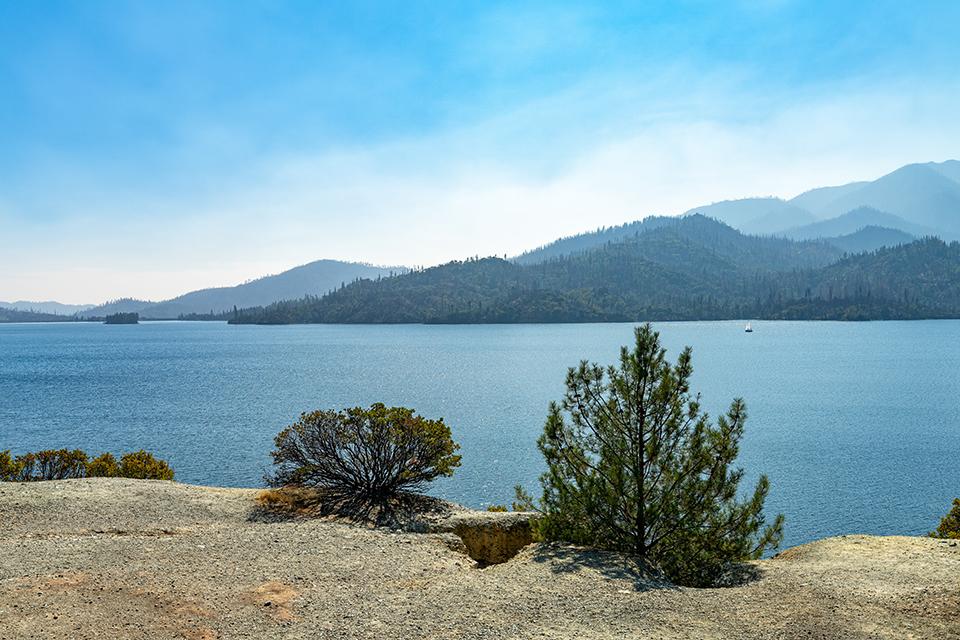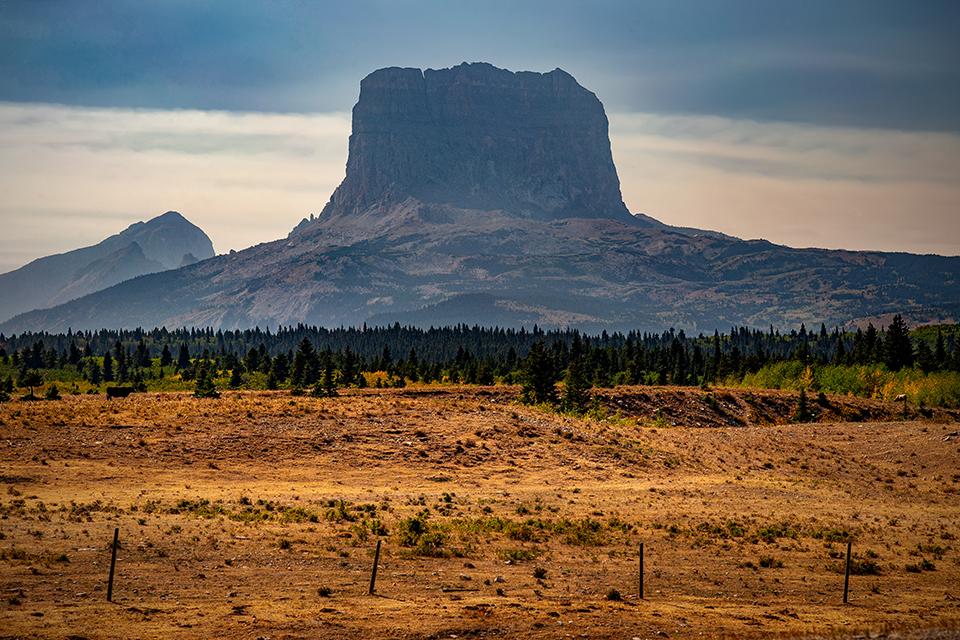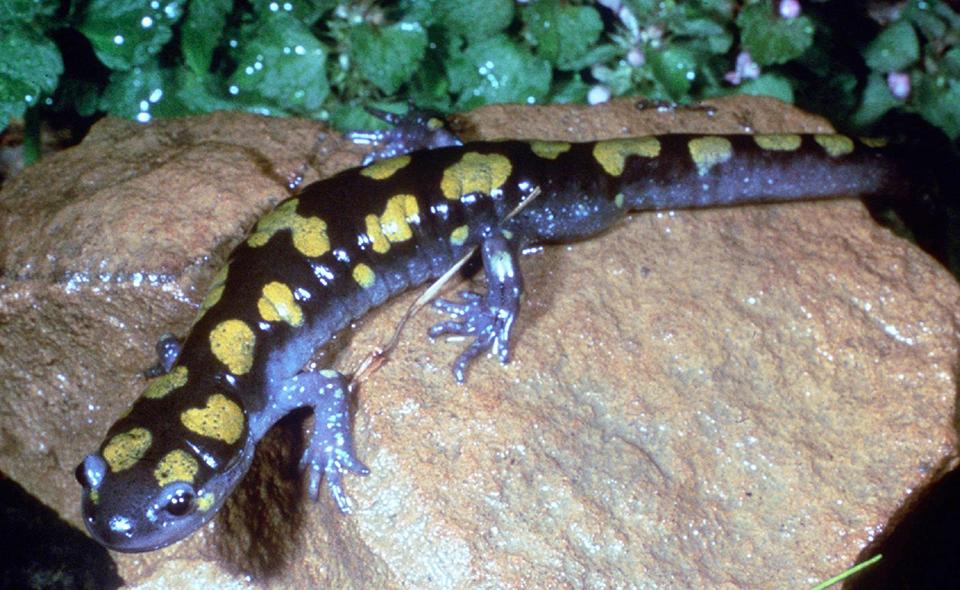
Picture Gorge Basalts, John Day Fossil Beds National Monument / Rebecca Latson
As I was tidying up my room the other day, I came across a number of national park books I didn’t remember I even owned (which goes to tell you how often I “tidy” up the room). Looking through them, I found more great info to use for quiz questions. So, without further ado, here is #27. Test your knowledge first before reading the answers at the bottom of this piece.
1. Turning left off of U.S. Highway 26 and onto Oregon Route 19 in the central part of the state, you enter the Sheep Rock Unit of John Day Fossil Beds National Monument. The first sight to greet you after you make that turn is an impressive wall of columnar basalts. These are called the Picture Gorge Basalts and they are comprised of how many layers?
a) 10
b) 13
c) 17
d) 19

A serene autumn scene of a smoky day on the lake, Whiskeytown National Recreation Area / Rebecca Latson
2. True or False: People used to prospect for silver in what is now Whiskeytown National Recreation Area.
a) True
b) False

Mud pots, Yellowstone National Park / Rebecca Latson
3. There are five types of hydrothermal features readily visible in Yellowstone National Park: hot springs, geysers, mud pots, travertine terraces, and ____.
a) fumeroles
b) thermophiles
c) sinter basins
d) geyserites

Haleakala Crater, Haleakala National Park / NPS-C.Fukushima
4. The word Haleakalā, of Haleakalā National Park, means:
a) home of Pele
b) long mountain
c) the house of the sun
d) white mountain

Canyon colors in the early morning, Grand Canyon National Park / Rebecca Latson
5. The most visited point on either rim of Grand Canyon National Park is:
a) Yaki Point
b) Roosevelt Point
c) Walhalla Overlook
d) Mather Point

Chief Mountain, Glacier National Park / Rebecca Latson
6. Chief Mountain, half located in Glacier National Park and half in the Blackfeet Reservation, is a sight to behold, standing out from the crowd. It’s a site of sacred ritual and ceremony for the Blackfeet going back thousands of years. Chief Mountain is also a premier example of something else:
a) a glacial erratic
b) a drumlin
c) a kame
d) a klippe
7. The Chateau at the Oregon Caves, at Oregon Caves National Monument and Preserve, served as a chance meeting place for two photographers during the 1930s – one of them with a tripod mounted with two cameras side by side. This meeting ultimately led to the invention of:
a) the motion picture
b) the stereoscope
c) the View-Master
d) the nature documentary
8. The 1960s version of Spartacus, featuring Kirk Douglas, Laurence Olivier, and Jean Simmons, was filmed in part in which national park?
a) Great Sand Dunes National Park and Preserve
d) Guadalupe Mountains National Park
9. Stehekin is a small community nestled at the north end of Lake Chelan in Lake Chelan National Recreation Area, a part of the North Cascades National Park Complex. The name Stehekin is based on a Salishan word meaning:
a) the way through
b) snow covered mountains
c) place on the water
d) forest by the lake

Spotted salamander, Great Smoky Mountains National Park / National Park Service
10. The Great Smoky Mountains are known as the “Salamander Capital of the World.” “Five families of salamanders are represented in the park: Cryptobranchidae, Proteidae, Salamandridae, Ambystomatidae, and Plethodontidae.” In the southern Appalachians, salamanders have a nickname:
a) slimy devils
b) spring lizards
c) puddle jumpers
d) snot otters
Trivia

Century of Progress, House of Tomorrow, Indiana Dunes National Park / NPS-Jack Boucher
“The House of Tomorrow at Indiana Dunes National Park is the creation of Chicago architect George Fred Keck. The first floor was designed as the service area, originally containing the garage and an airplane hangar. World's Fair optimists assumed every future family would own an airplane. The second and third floors were the essence of the house, containing the main living spaces and a solarium. The three-story, steel-framed building was originally clad in glass on the second and third floors. Keck defied mechanical engineers, who said that due to the expansive use of glass the house couldn't be heated, and installed a floor to ceiling "curtain wall system". Instead of heat loss during the winter, the level of solar heat gain actually reduced the need for mechanical heating. During the summer the solar gain was too great for the home's revolutionary air-conditioning system to handle, and it failed. When Robert Bartlett moved the house from Chicago to Beverly Shores after the world's fair, he replaced the glass walls with operable windows to allow for proper air circulation.”

Pothole Point Trail, Needles District, Canyonlands National Park / Rebecca Latson
A hike along the pothole-pitted slickrock sandstone of Pothole Point in the Needles District of Canyonlands National Park might lead you to believe these big and little potholes are devoid of much other than sand and dirt. But these shallow little depressions are actually “complete ecosystems.” Add a little water from spring rains, and a whole world springs to life, including fairy shrimp, tadpoles, gnat larvae, tadpole shrimp, snails, and beetle larva. Over time, the potholes may fill with sand and soil and enough moisture to allow a garden to spring forth, including grasses, herbs, and yucca. To learn more about potholes and the Pothole Point hike, click here.

Strawberry pitaya cactus in bloom, Big Bend National Park / Rebecca Latson
Spring is a great time to visit Big Bend National Park. The temperatures are mild and the mornings are rather chilly. Some people specifically visit this national park during the spring time, not only for the cooler weather, but also to view the brilliantly saturated flowers of blooming cacti and succulents. This usually occurs during mid-late April. “Cacti and succulents use a photosynthesis process called Crassulacean Acid Metabolism or CAM. Minute pores in the plant's skin surface—called stomata—open only at night. Carbon dioxide is absorbed through these minute openings and chemically stored as an organic acid. Much less stored moisture is lost by the plant's use of this nightly process. During the day, carbon dioxide is internally released from the acid and made available to the plant. The trade-off in this delayed system of photosynthesis is that cacti and succulent species generally grow very slowly.” To learn more about cacti and succulents, click here.
Quiz Answers
1c
“The Picture Gorge Basalts (PGBs) are 17 individual layers of flood basalts that create a spectacular southern entrance to the Sheep Rock Unit of the monument. The PGBs covered approximately 2,500 square miles in basaltic lava, with some flows being over 50 feet deep. All together the basalts in this area are over 1,300 feet deep. Picture Gorge Basalts are a subgroup of the Columbia River Basalts, which include hundreds of lava flows in the Pacific Northwest.”
2b False
Gold was a driving force for exploration into the Whiskeytown area. One prospector even discovered a 17-pound gold nugget.
3a
“A fumarole, or steam vent, exists when a hydrothermal feature has so little water in its system that the water boils away before reaching the surface. Steam and other gases emerge from the feature's vent, sometimes hissing or whistling. Steam vents are often superheated, with temperatures as high as 280°F (138°C).” To read more about these five types of hydrothermal features, click here.
4c
While Pele is the Goddess of Volcanoes, Haleakalā does not mean home of Pele (Kilauea Volcano is where Pele lives). Haleakalā means “the house of the sun.” “Haleakalā is the big volcanic mountain that forms the eastern part of the island of Maui. It started its growth as a typical shield volcano like Kilauea and Mauna Loa. Thousands of thin flows of olivine basalt and closely related lavas followed each other in rapid succession, until the shield had been built from the ocean floor to an altitude 8,000 feet above the present sea level.”
5d
Mather Point is the most visited point on either rim. Named after Stephen Tyng Mather, the first director of the National Park Service, from this view area, you can see the Inner Gorge, a bit of the Colorado River, Isis Temple, and the South Kaibab Trail.
6d
According to the National Park Service’s Geodiversity Atlas portion on Glacier National Park, Chief Mountain is a klippe, “a geologic term for the erosional remnant of older rocks in a thrust sheet completely detached from comparably aged rocks trailing behind. Like the Lewis Overthrust itself, Chief Mountain is considered one of the world’s outstanding examples of a klippe; its images grace the pages of many geologic textbooks.” To look at more of the NPS’s Geodiversity Atlas for Glacier, click here.
7c
Harold Graves and William Gruber met in Grave’s room at the Chateau, where Gruber described his idea for what would later become the View-Master. To learn more about the history of the View-Master, which was inducted into the National Toy Hall of Fame in 1999, click here.
8b
The landscape of Death Valley National Park has provided backdrops for many movies, including epics like Spartacus and The Greatest Story Ever Told.
9a
“The name ‘Stehekin’ is based on a Salishan word meaning ‘the way through.’ The Stehekin valley has long served as a passageway for travelers, linking Washington’s interior wilderness to the rugged Cascade Mountains. There are no roads into Stehekin. Connected to the outside world only by foot, boat or plane, the voyage to Stehekin is part of the experience and once you’ve arrived, a variety of historical, cultural, and outdoor activities will connect you with the majestic surroundings. Stehekin serves as a hub to explore the 61,949-acre Lake Chelan National Recreation Area and a gateway to the rest of the North Cascades National Park Service Complex, Stephen Mather Wilderness, and adjacent National Forest Wilderness Areas.”
10b
“Salamanders are commonly called ‘spring lizards’ in the southern Appalachians. Lizards and salamanders are, however, very different sorts of animals: salamanders are amphibians while lizards are reptiles. The skins of salamander lack scales and are moist or slimy to the touch. Their eggs are surrounded by clear jelly. Lizards on the other hand, have scales on their skin, and are dry to the touch. They lay eggs with leathery shells.” To read more about salamanders and other amphibians found in Great Smoky Mountains National Park, click here.
References
In addition to the information from the National Park Service for each park site, I also used the following publications.
DK Eyewitness USA National Parks, Lands of Wonder, 2020, Penguin Random House
David L. Scott and Kay W. Scott, The Complete Guide To The National Park Lodges, 2018, Globe Pequot
Al M. Rocca, Whiskeytown National Recreation Area, A History, 2010, Renown Publishing
Gordan A. Macdonald and Douglass H. Hubbard, Volcanoes Of The National Parks In Hawai’i, 2007, Hawai’i Pacific Parks Association
Michael F. Anderson, Along The Rim: A Guide To Grand Canyon’s South Rim, From Hermits Rest To Desert View, 2001, Grand Canyon Association



Comments
Another good one Rebecca! Thanks again for all your work and efforts to help folks learn about our national parks!
And thank *you*, Chip, for your kind words and avid readership!
Really enjoyed this quiz! We've been to most of these places in the NPS. Always learn something new!